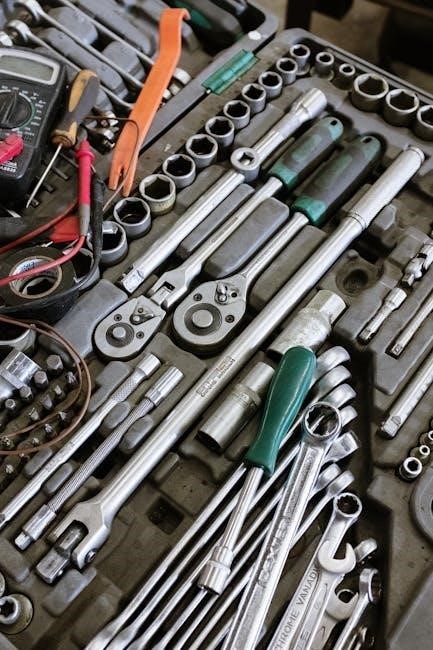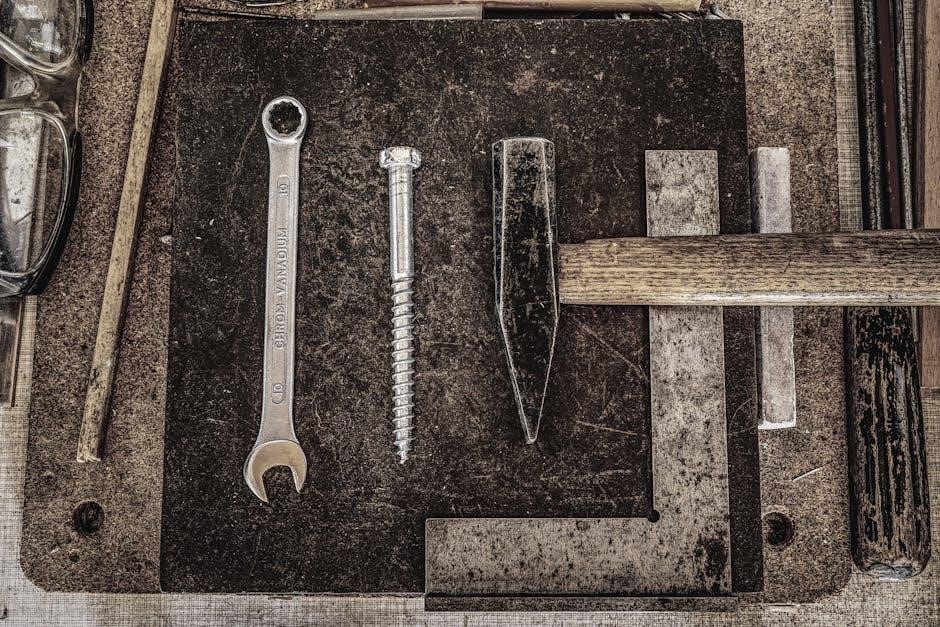Pocket hole joinery revolutionizes woodworking by offering a strong, hidden joint solution. Ensuring correct screw length is crucial for optimal strength, and tools like the screw length guide simplify this process.
Understanding Pocket Holes
Pocket holes are angled holes drilled into wood, allowing screws to be inserted at a 15-degree angle for strong, hidden joints. The Kreg Jig simplifies this process with a specialized drill bit. Correct screw length ensures the screw penetrates the second piece without splitting the wood. Online resources, like the Kreg Screw Selector Tool, help determine the ideal screw size based on material thickness. This ensures joints are both durable and visually appealing, making pocket hole joinery a versatile technique for woodworking projects of all sizes.
Importance of Correct Screw Length
Correct screw length is crucial for ensuring strong, durable joints in pocket hole joinery. Screws that are too long can split the wood, leading to weakened joints, while those too short may fail to hold the pieces securely together. The Kreg Screw Selector Tool offers precise recommendations based on material thickness, helping woodworkers avoid these common mistakes. By using the correct screw length, craftsmen ensure a strong, reliable bond without compromising the wood’s integrity, which is essential for the success and longevity of any project.

Setting Up the Kreg Jig
Proper setup ensures accurate pocket holes and strong joints. Measure wood thickness, adjust the jig accordingly, and use the screw length guide to avoid drilling errors.
Measuring Wood Thickness
Accurate wood thickness measurement is vital for proper jig setup. Use a tape measure to determine the material’s thickness, ensuring precise adjustment of the Kreg Jig. This step prevents over-drilling or under-drilling, which can weaken joints. Always double-check measurements to avoid errors. Correct thickness measurement ensures the screw length guide provides the right screw size, optimizing joint strength and durability. Proper alignment starts with accurate thickness assessment, making it a foundational step in successful pocket hole joinery.
Adjusting the Jig for Material Thickness
Adjusting the Kreg Jig to match material thickness ensures accurate pocket holes and proper screw alignment; Measure the wood thickness using a tape measure, then set the jig accordingly. The jig features adjustable stops that lock in place for consistent drilling. Refer to the screw length guide to confirm the correct setting for your material. Proper adjustment prevents over-drilling and ensures screws sit flush, creating strong, durable joints. Always double-check the thickness setting before drilling to avoid errors and maintain joint integrity.

Using the Screw Length Guide
The screw length guide is an essential tool for ensuring accurate screw selection in pocket hole joinery. To use it effectively, measure the material thickness, adjust the Kreg Jig accordingly, and consult the guide for the recommended screw length. This ensures strong, flush joints without protrusion or splitting, optimizing joint strength and project durability.
Locating the Guide on the Jig
The screw length guide is typically located on the side or base of the Kreg Jig, depending on the model. For most models like the K3, K4, or K5, it is clearly marked and easy to access. To locate it, refer to the jig’s documentation or look for a chart or scale printed directly on the tool. This guide is essential for determining the correct screw length based on material thickness, ensuring strong and secure joints. Always double-check the guide before drilling to avoid mistakes and achieve professional results;
Interpreting the Guide for Screw Selection
The screw length guide on the Kreg Jig provides a straightforward chart or scale that correlates material thickness with the recommended screw length. To interpret it, align the jig’s adjustment with your material’s thickness and reference the corresponding screw length. This ensures joints are strong and prevents screws from being too short or long. The guide is designed to be intuitive, making it easy for beginners and experienced woodworkers alike to select the right screws efficiently and accurately.

Choosing the Right Screw Type
Choosing the right screw type ensures strong joints. Coarse-thread screws are ideal for thick materials, while fine-thread screws work best for thinner woods. Use specialized screws for thin materials and consult the Kreg Screw Selector Tool for precise recommendations.
Coarse vs. Fine Thread Screws
Coarse-thread screws are designed for thicker materials, offering superior holding power due to their deep threads. Fine-thread screws are better suited for thinner woods, reducing the risk of splitting. Choosing the right type ensures optimal joint strength and prevents material damage. The Kreg Screw Selector Tool provides guidance for selecting the appropriate screw based on material thickness, ensuring a secure and professional finish in woodworking projects. Proper screw selection is crucial for the longevity and integrity of the joint.
Specialized Screws for Thin Materials
For thin materials, specialized screws like micro-pocket or pan-head screws are ideal. These screws have smaller diameters and unique head designs, reducing the risk of splitting delicate wood. They are specifically engineered for materials with limited thickness, ensuring secure joints without compromising the material’s integrity. When working with thin woods, it’s essential to refer to the screw length guide to select the appropriate screw type and length, preventing over-drilling or weak connections. This ensures a professional and durable finish for your projects.

Utilizing Online Resources
Kreg offers an online Screw Selector Tool to help determine the ideal screw type and length for your projects. Model-specific guides ensure accurate selections for K3, K4, and K5 jigs, providing tailored solutions for various woodworking needs and material thicknesses.
Kreg Screw Selector Tool
The Kreg Screw Selector Tool is a free online resource designed to simplify screw selection. By inputting wood thickness and screw type, it provides precise recommendations. This tool ensures optimal joint strength and prevents common mistakes. It’s user-friendly, catering to both beginners and experienced woodworkers. Available on the Kreg website, it’s a valuable asset for any project, eliminating guesswork and saving time. The tool’s accuracy makes it an essential resource for achieving professional-grade results with pocket hole joinery.
Model-Specific Guides (e.g., K3, K4, K5)
Kreg offers model-specific guides for their pocket hole jigs, such as the K3, K4, and K5. These guides provide detailed recommendations tailored to each jig’s capabilities. For example, the Kreg K5 includes advanced features like adjustable drill guides, while the K3 is more compact. Each model’s guide ensures screws are selected based on material thickness and project requirements. These resources are available online or with the jig, helping users avoid errors and achieve strong joints. They’re essential for maximizing the potential of each Kreg jig model.

Practical Application and Tips
Drill pocket holes in scrap wood to test settings and avoid errors. Always use the screw length guide for precise measurements, ensuring strong and durable joints.
Drilling Pocket Holes in Scrap Wood
Drilling pocket holes in scrap wood is a practical way to test your Kreg Jig setup. Start by adjusting the jig for your material thickness and use the screw length guide to ensure accuracy. Practice drilling holes to confirm proper alignment and depth. This step helps avoid costly mistakes on actual projects. Always test with wood of the same thickness as your project material. Pay attention to screw length to ensure joints are strong and durable. Scrap wood testing ensures consistency and confidence in your pocket hole joinery skills.
Avoiding Common Mistakes
Avoiding common mistakes is crucial for successful pocket hole joinery. Ensure the Kreg Jig is properly calibrated for your material thickness and always double-check the screw length guide. Incorrect screw lengths can lead to weak joints or material damage. Misaligned holes are another common issue, so maintain steady pressure while drilling. Using the wrong screw type for your material can also compromise joint strength. Regularly inspect and maintain your jig to prevent wear-related errors. Testing on scrap wood first helps identify and correct potential mistakes before working on your final project.
Mastery of the Kreg Jig screw length guide ensures accurate and durable joints. Proper setup and screw selection are key, making practice and patience essential for success;
Best Practices for Strong Joints
- Always measure wood thickness accurately to ensure proper screw placement and length selection.
- Use the Kreg screw length guide to avoid over- or under-driving screws, which can weaken joints.
- Drill pocket holes in scrap wood first to test screw fit and prevent mistakes in your project.
- Ensure the jig is properly aligned with the wood edge for consistent results.
- Avoid over-tightening screws, as this can cause material splitting or joint failure.
Final Thoughts on Using the Kreg Jig
Using the Kreg Jig is a game-changer for woodworking projects, offering precision and efficiency in creating strong joints. Always refer to the screw length guide for optimal screw selection. Properly aligning the jig and measuring wood thickness ensures professional-grade results. Testing on scrap wood first helps avoid costly mistakes. The Kreg Screw Selector Tool is an invaluable resource for quick and accurate screw selection. By following these steps, you can achieve durable, invisible joints that enhance the quality of your woodworking projects.




